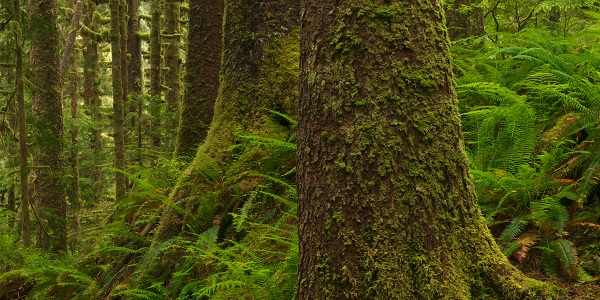A new climate for the Great Bear Rainforest Agreements
posted by: Administrator, February 15, 2012 at 1pm
British Columbia is home to some of the most spectacular forest landscapes on the planet, above all the temperate rainforest along the Pacific Coast. These forests – including the Great Bear Rainforest – are not only globally rare and home to species that exist nowhere else, like the rare white spirit bear; they also contain some of the largest carbon stores per hectare of any ecosystem in the world.
How does this work? In really simple terms, plants absorb carbon dioxide from the atmosphere. Some of that carbon ends up in the soil while much of it is stored in trees. On the most productive sites, old-growth forests store over 1,000 tonnes of carbon per hectare and, on average, sequester another two tonnes of carbon annually. Old-growth forests can only store this much carbon, though, if they’re still standing.
Logging old-growth forests releases large amounts of its stored carbon into the atmosphere. Clearcuts continue to emit carbon from exposed soils and logging residue for decades before the carbon uptake of second-growth forest begins to offset the loss.
The critical role the Great Bear Rainforest plays in helping slow climate change is one of the reasons Sierra Club BC, ForestEthics and Greenpeace are calling on the provincial government to speed up the outstanding steps of the Great Bear Rainforest Agreements announced on February 7, 2006.
An ecological pillar of the Great Bear Rainforest Agreements is the scientific recommendation to set aside 70 percent of the natural level of old-growth forests. An estimate of the carbon benefits of implementing this step through logging regulation based on Ecosystem-Based Management (EBM) shows that this move would prevent around 150 million tonnes of carbon dioxide from being released into the atmosphere, which is more than twice the official annual emissions of the province of B.C.

Photo: Markus Mauthe/Greenpeace
The Great Bear Rainforest Agreements are not just a blueprint for healthy ecosystems and healthy communities. Once fully implemented, they will also help to ensure the Great Bear Rainforest continues to act as a crucial carbon bank and increase survival rates of species that would be unable to adapt to climate change in landscapes fragmented by clearcuts. But time is not on our side. That’s why we’re asking the provincial government to fully implement the agreements by March 31, 2013.
In short? Speeding up protection of the Great Bear Rainforest will keep carbon on the ground, will give many species a better chance to adapt to a changing climate, inject new support for economic activities that support local communities and don’t undermine the environment, and give logging companies certainty about the best places for sustainable forestry in the long-term.
The planet is warming, carbon emissions are increasing and nature is under serious stress due to a changing climate. Increasing protection of our old-growth forests is one of the most effective decisions we can take to reduce emissions and protect species right now, and in our own backyard. So let’s step up to the plate for one of our best allies in the fight against global warming, the Great Bear Rainforest.
Take action at www.takeittaller.ca